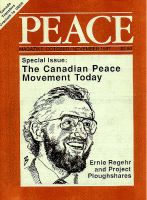
Peace Magazine Oct-Nov 1987, page 41. Some rights reserved.
Search for other articles by John Bacher here
Thomas Socknat, Witness Against War: Pacifism in Canada 1900-1945. Toronto: Univ of Toronto Press 1987, $16.95 softcover
Thomas P. Socknat's Witness Against War, is a valuable remedy for the historical amnesia of the Canadian peace movement. Peace activists will be strengthened by its reminder that their predecessors stood firm in their beliefs against an often hostile Canadian society, while nevertheless influencing it to a remarkable extent.
Witness Against War documents the heavy persecution of Canadian pacifists from the Boer War to World War H, and shows that it was more difficult in Canada to criticize our participation in British Wars, than to criticize these conflicts in Britain itself. Reverend James Herbert Bainton, newly arrived from England in 1899, left for the United States after his congregation split when he asked God to look with compassion on the British and Boer alike. Pioneering Canadian social democrat F. J Dixon bravely resisted threats of expulsion and imprisonment that were made to silence his criticism of World War I in the Manitoba Legislature. After congratulating Dixon on one of his anti-war speeches, reform minded Winnipeg journalist A. Vernon Thomas was fired from the Free Press. CCF founder J.S. Woodsworth was removed from his small coastal mission in British Columbia and forced to spend the remainder of World War I working as a longshoreman. Conscientious objectors were tortured into accepting military authority at Winnipeg's Minto Street Barracks. After being sent to England during World War I, conscientious objectors were beaten over the head, kicked with heavy boots until unconscious and even dragged to the edge of cliffs where they were threatened to be thrown over. At the outset of World War II, 68 United Church Ministers signed a "Witness against War," published in the United Church Observer, causing in "most cases,, "a corps of wealthy congregational leaders" to denounce the pacifist ministers and obtain their resignations.
Despite their clashes with powerful forces in Canadian society, Socknat demonstrates the remarkable impact pacifists were able to have on ii Prior to their campaigns against compulsory cadet instruction in secondary school, physical education for boys was largely a supplement to military training. Pacifists also played an important role in the freeing of interned Jewish refugees during World War II, in preventing the expulsion of Japanese Canadians after that war, and in the growth of the cooperative movement.
Although giving an impressive account of Canadian pacifists' achievement, Socknat does point to some limitations in their vision and priorities. After outlining the call by the United Church of Canada moderator Richard Roberts for an international conference on the likely threat of aerial warfare upon non-combatant populations living in cities, Socknat notes that this was one of the few efforts of Canadian pacifists to articulate "the stark reality of the disarmament question." Likewise, Socknat admits that the "isolationist tinge" of some aspects in the Canadian peace movement played a role in the infamous "Riddell incident" This saw the Canadian government withdraw its League of Nations support for oil sanctions against Italy for its invasion of Ethiopia The failure of Canadian pacifists to develop a coherent strategy of non-violent resistance also encouraged the rapid shrinking of pacifism after the start of the Spanish Civil War. Socknat also notes the failure of Canadian pacifists to highlight nuclear related issues immediately following World War ll. They preferred a focus on more familiar areas of protest, such as opposition to compulsory cadet instruction.
The main weakness in Witness Against War is in its discussions of pre-20th century Canadian pacifism and the peace movement since W.W.II. These areas really lie outside the focus of the book and require separate study. Many of Socknat's generalities posed about the emergence of the Canadian Peace Congress "and its dominance throughout the early 1950s" need to be set in an international context with reference to similar organizations affiliated to the World Peace Council. Little attention is paid to the importance of debates within the Communist Party and the Co-operative Commonwealth Federation (CCF) for the evolution of the peace movement. Socknat's interesting but brief account of the crucial 1939 CCF national council debate on Canadian participation in World War II is one of many signs that additional historical research is needed on our peace movement.

Peace Magazine Oct-Nov 1987, page 41. Some rights reserved.
Search for other articles by John Bacher here